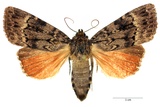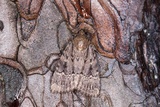Amphipyra berbera Rungs, 1949 Species
Last modified: Nov. 18, 2025, 5:12 p.m.
A fairly common species throughout Belgium.
This species is considered Least Concern according to the IUCN Red List category for Flanders 2023.
Details
- Classification
- Family: Noctuidae > Subfamily: Amphipyrinae > Genus: Amphipyra > Species: Amphipyra berbera
- Vernacular names
- Schijn-piramidevlinder (NL), Svensson's Copper Underwing (EN), La Noctuelle berbère (FR), Svenssons Pyramideneule (DE)
- First mention in Belgium
- Legrain A. 1971. Espèces nouvelles pour la faune belge (suite). — Lambillionea 70 (1970): 83–90. On page 86.
- Status
-
Native
Distribution
Bionomics
Hibernates as an egg in bark crevices. Pupation in a cocoon among plant debris or under the ground.
The adults come to sugar, wineroping and to light.
During the day, they can be found in hollow trees, buildings, behind bark or in nest-boxes, often in group and sometimes together with Amphipyra pyramidea.
No pictures yet!
Flight periods
The adults fly in one generation a year from mid-July till the end of September, occasionally later.
Observed on
- Host plant (species):
- Syringa vulgaris
- Host plant (genera):
- Quercus, Carpinus, Fagus, Salix, Tilia and Rhododendron
- Substrates:
- Deciduous trees and Shrubs
The larva lives on a range of trees and shrubs like Quercus, Fagus, Salix, Tilia, Rhododendron etc...
No pictures yet!








